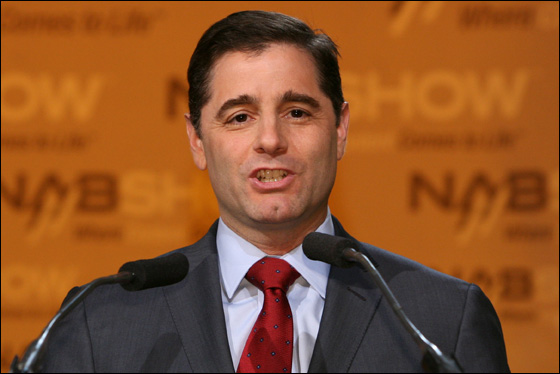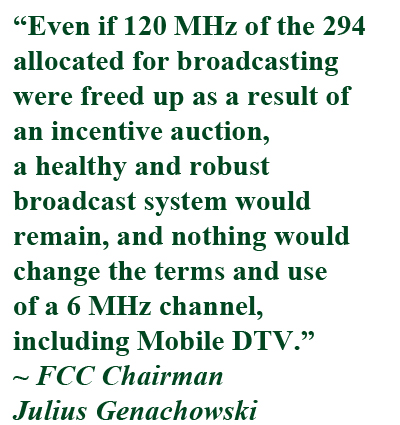Genachowski Dismisses Arguments Against Incentive Auctions

LAS VEGAS: Around 400 people quickly packed a Hilton ballroom at 7:30 morning as folks in the broadcast industry gathered to hear what the point-man on spectrum reassignment had to say. Federal Communications Commission Chairman Julius Genachowski went directly to the subject of incentive auctions in which broadcasters would receive a cut of proceeds--the mechanism by which the FCC intends to reassign the airwaves.
“This idea has strong momentum,” he said.
The FCC needs Congressional authorization to hold incentive auctions. Bills granting it are pending in the House and the Senate. If authorization is obtained, Genachowski pledged to work closely to broadcasters on implementation. While there would be legitimate issues to be addressed, he said some of the arguments against incentive auctions amount to distractions.
“Some have argued there’s no spectrum crunch, but the data couldn’t be clearer,” he said. “There’s no big swath of spectrum hidden in a warehouse somewhere.”
Broadcast interests have alleged as much--that cable and satellite companies are warehousing spectrum. Genachowski said the licensing system requires those who win spectrum to build it out.
“Some have argued incentive auctions will stop Mobile DTV. It will not,” he said. “Even if 120 MHz of the 294 allocated for broadcasting were freed up as a result of an incentive auction, a healthy and robust broadcast system would remain, and nothing would change the terms and use of a 6 MHz channel, including Mobile DTV.”
Some have argued for waiting to change the DTV transmission standard. Genachowski said that was a separate issue. He dismissed charges that incentive auctions would favor urban over rural markets.
“Incentive auctions will have little if any effect in rural America, because spectrum supply is much less of an issue in less populated areas,” he said.
As for broadcasters who elect not to participate in the auctions, they would be compensated for the cost of moving to new channels. They would not, however, be guaranteed the right to stay on a channel.
“This would not only be unprecedented, it would give any one broadcaster veto power over the success of the auction,” he said.
He reasoned that there would be minimal service disruptions for consumers because the DTV transition allowed stations to move to new frequencies without changing virtual channels.
Genachowski said he would be “straight and fair and focused on problem solving,” going forward. “I ask the same of you.”
APPS IN THE PUBLIC INTEREST
He reminded the audience that he once worked in the industry, launching TV stations for USA Broadcasting.
“I do remember the challenges of being successful,” he said. “These are hard challenges. I’ve seen them first hand.”
The chairman waxed on the evolution of the industry since his days in broadcasting. He said the average American now spends more time online than watching TV, and that 25 million folks are watching TV on their smartphones--up 40 percent from a year ago. Add to that tablet computers and you’ve got yourself a “multiplatform world.”
“I understand this world presents challenges to broadcasters,” he said, “like fragmenting audiences and multiple pressures on ad revenues.”
Genachowski said he was “pleased” to see broadcasters embracing the multiplatform ethos, particularly with Mobile DTV.
“We don’t know what will work in the marketplace, but nothing we are considering would or should interfere with market-based innovation around Mobile DTV,” he said.
He acknowledged other multiplatform strategies pursued by broadcasters, including Univision’s originals for the Web and mobile devices; ABC’s early iPad app, and the deployment of hyperlocal websites.
“I see this all as highly relevant to the public interest obligations broadcasters have,” he said.
The chairman noted how TV stations are a primary source of local news in several markets, but that not all stations do news.
In quite a few markets, local TV station Web sites are the primary. Some cant’ afford it, he said, but the influences the way the industry’s spectrum needs are evaluated.
RETRANSMISSION REFORM RESISTENCE
On the retransmission front, Genachowski reminded that he resisted calls for government intervention, but last fall’s World Series black-out in New York compelled commission action. A retransmission Notice of Proposed Rulemaking was issued in March. The proceeding seeks feedback on the impact of retrans fees on consumers, among other things.
“I look forward to input from all parties,” he said. “Meanwhile, the FCC will also look at whether there are regulatory barriers that can be reduced or eliminated, or initiatives that should be considered, to support the efforts broadcasters are making to reach the audience that’s increasingly relying on broadband-connected computers, smartphones and tablets.”
One area of inquiry is audience measurement on digital platforms, and whether or not the FCC can do anything to move it along, he said.
MORE MORE MORE SPECTRUM
Genachowski said that two years ago, few people were talking about broadband, and that it’s now considered essential to the economy. He said when the FCC issued the National Broadband Plan a little over a year ago, mobile data consumption projections predicted a 35x increase over five years. That was before tablets computers, 55 million of which are expected to be sold this year.
“The growing demand is not going away,” he said. “The result is a spectrum crunch. . . The only thing that can address the growing overall demand for mobile is increasing the overall supply of spectrum and the efficiency of its use.”
The FCC has already launched proceedings to explore spectrum efficiency, sharing in secondary markets, eliminate restrictions on certain bands and other such strategies to free up bandwidth. He said those still wouldn’t be enough to fulfill the demand for mobile broadband.
“I believe the single most important step that will drive our mobile economy and address consumer frustration is authorizing voluntary incentive auctions.”
~ Deborah D. McAdams

Get the TV Tech Newsletter
The professional video industry's #1 source for news, trends and product and tech information. Sign up below.
